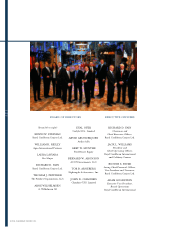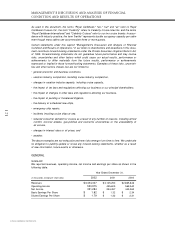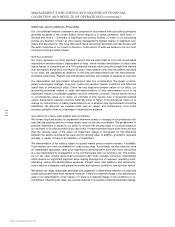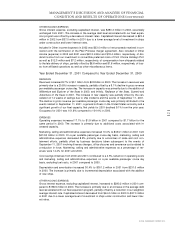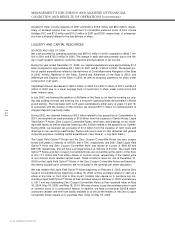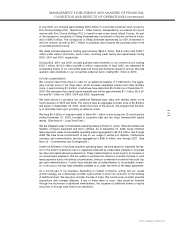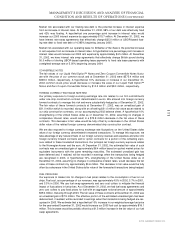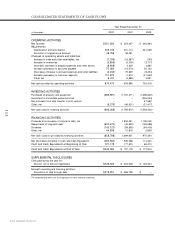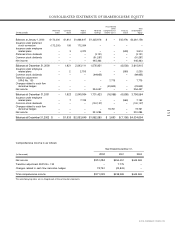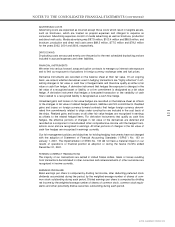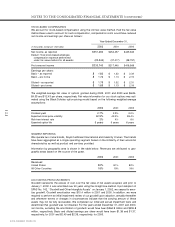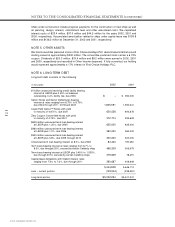Royal Caribbean Cruise Lines 2002 Annual Report Download - page 24
Download and view the complete annual report
Please find page 24 of the 2002 Royal Caribbean Cruise Lines annual report below. You can navigate through the pages in the report by either clicking on the pages listed below, or by using the keyword search tool below to find specific information within the annual report.
22
ROYAL CARIBBEAN CRUISES LTD.
MANAGEMENT'S DISCUSSION AND ANALYSIS OF FINANCIAL
CONDITION AND RESULTS OF OPERATIONS (continued)
FUNDING SOURCES
As of December 31, 2002, our liquidity was $1.2 billion consisting of approximately $0.2 billion
in cash and cash equivalents and $1.0 billion available under our $1.0 billion unsecured revolv-
ing credit facility. Our $1.0 billion revolving credit facility expires in June 2003. Any amounts out-
standing at that time will be payable immediately if the facility is not replaced. We intend to
replace this facility prior to its expiration date, although such replacement may be at an amount
less than $1.0 billion. In addition, we have commitments for export financing for up to 80% of
the contract price of two ships on order,
Serenade of the Seas
and
Jewel of the Seas
, not to
exceed $624.0 million in aggregate. Capital expenditures and scheduled debt payments will be
funded through a combination of cash flows from operations, drawdowns under our available
credit facilities, the incurrence of additional indebtedness and the sales of equity or debt secu-
rities in private or public securities markets. Geo-political and economic uncertainties coupled
with market volatility have adversely impacted terms and availability of financing in the financial
markets, and it is indeterminable how long this situation will continue. Therefore, there can be
no assurances that cash flows from operations and additional financing from external sources
will be available in accordance with our expectations.
Our financing agreements contain covenants that require us, among other things, to maintain
minimum liquidity, net worth, and fixed charge coverage ratio and limit our debt to capital ratio.
We are in compliance with all covenants as of December 31, 2002.
We believe our availability under current existing credit facilities, cash flows from operations and
our ability to obtain new borrowings and/ or raise new capital will be sufficient to fund opera-
tions, debt payment requirements and capital expenditures over the next year.
FINANCIAL INSTRUMENTS AND OTHER
GENERAL
We are exposed to market risk attributable to changes in interest rates, foreign currency
exchange rates and fuel prices. We minimize these risks through a combination of our normal
operating and financing activities and through the use of derivative financial instruments
pursuant to our hedging practices and policies. The financial impacts of these hedging instru-
ments are primarily offset by corresponding changes in the underlying exposures being hedged.
We achieve this by closely matching the amount, term and conditions of the derivative instrument
with the underlying risk being hedged. We do not hold or issue derivative financial instruments
for trading or other speculative purposes. Derivative positions are monitored using techniques
including market valuations and sensitivity analyses. (See Note 11 – Financial Instruments.)
INTEREST RATE RISK
Our exposure to market risk for changes in interest rates relates to our long-term debt obli-
gations and our operating lease for
Brilliance of the Seas
. We enter into interest rate swap
agreements to modify our exposure to interest rate movements and to manage our interest
expense and rent expense.
Market risk associated with our long-term fixed rate debt is the potential increase in fair value
resulting from a decrease in interest rates. At December 31, 2002, our interest rate swap
agreements effectively changed $375.0 million of fixed rate debt with a weighted-average
fixed rate of 7.58% to LIBOR-based floating rate debt. The estimated fair value of our long-
term fixed rate debt at December 31, 2002, excluding our Liquid Yield Option™ Notes and
Zero Coupon Convertible Notes, was $2.2 billion using quoted market prices, where avail-
able, or using discounted cash flow analyses based on market rates available to us for simi-
lar debt with the same remaining maturities. The fair value of our associated interest rate
swap agreements was estimated to be $64.0 million as of December 31, 2002 based on
quoted market prices for similar or identical financial instruments to those we hold. A hypo-
thetical one percentage point decrease in interest rates at December 31, 2002 would
increase the fair value of our long-term fixed rate debt, excluding our Liquid Yield Option™
Notes and Zero Coupon Convertible Notes, by approximately $80.3 million, net of an
increase in the fair value of the associated interest rate swap agreements.


